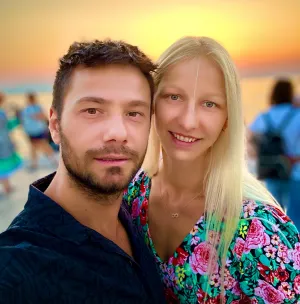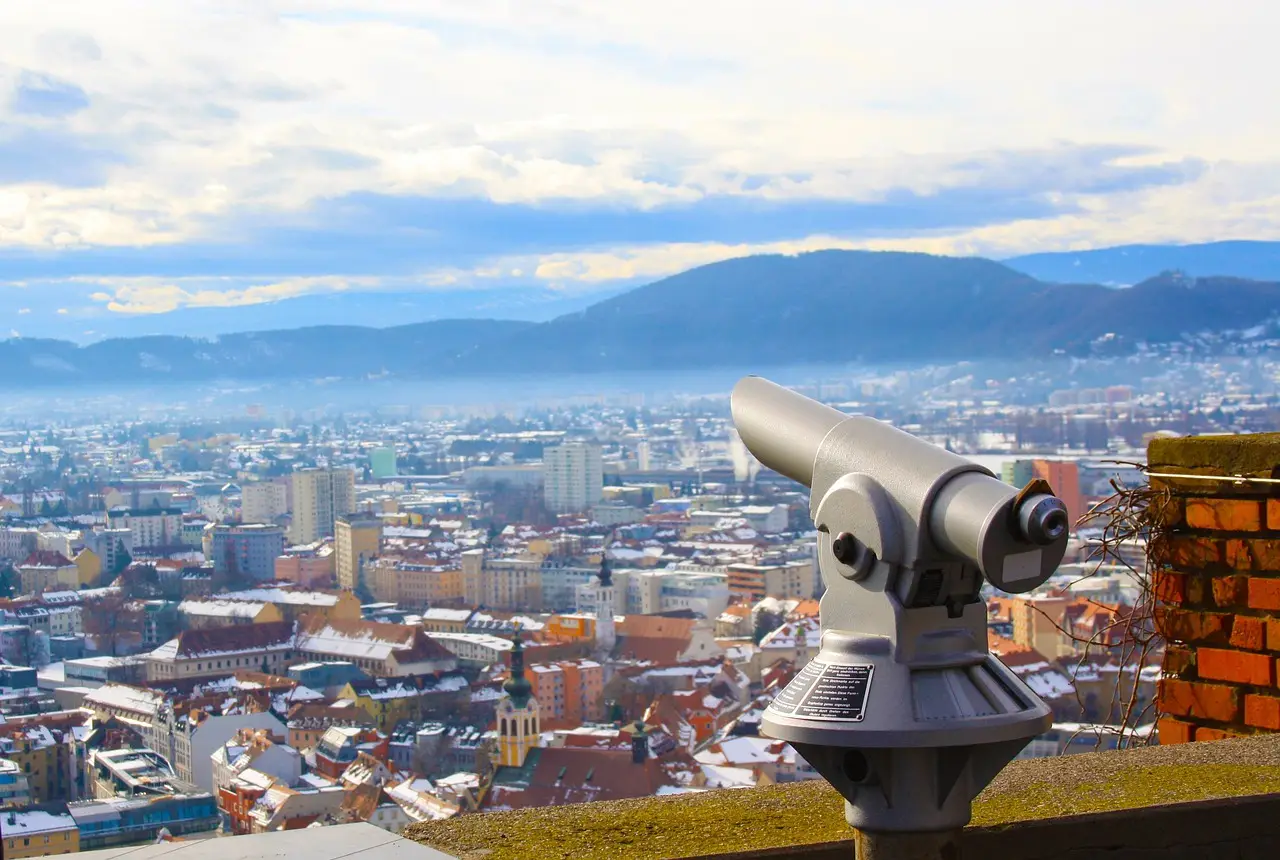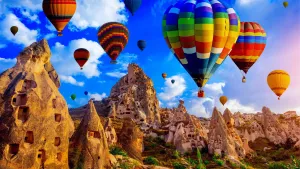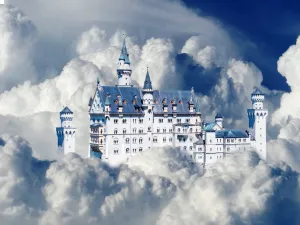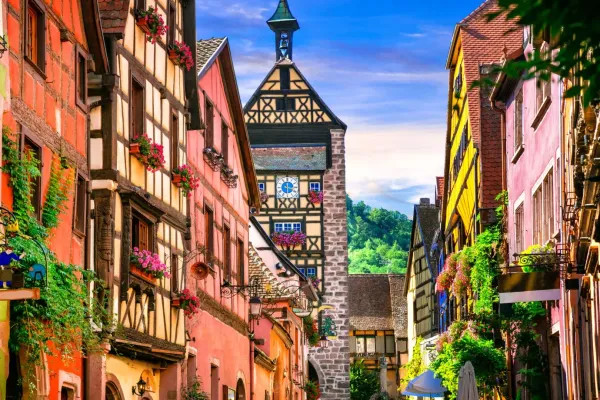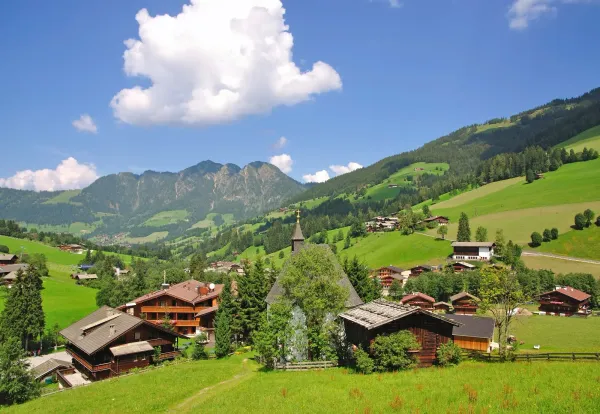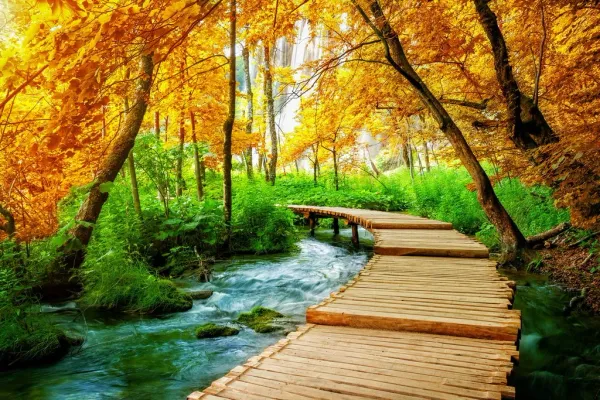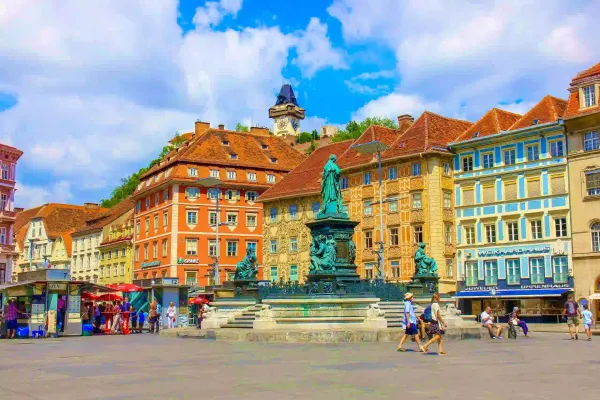Graz is the capital of the Austrian state of Styria, located further south in the country, near Slovenia and Hungary.
It is famous for its beautifully preserved Old Town and modern architecture, which makes it part of UNESCO, as well as for its rich selection of cultural entertainment and lively nightlife brought to life by its countless students.
In addition, there is a lot to see in Graz, but when everything has already been discovered, it's time to go outside the city to see what its surroundings have to offer.
Beautiful nature trails, historic castles and stunning abbeys, mysterious lakes, fascinating museums, beautiful neighboring countries and much more within 200 kilometers from Graz.
Explore with us and add to your list the most exciting places to visit near Graz as day trips!
1. Schöckl Mountain
Just outside the city you can relax at the legendary Schöckl, Graz's local mountain.
The Schöckl mountain is located approximately 20 kilometers north of the city of Graz and offers countless activities for all tastes, at any time of the year, making it one of the most popular destinations around Graz.
Hike along its many hiking trails and reach its summit at 1,445 m above sea level. From there you will be rewarded with 360-degree panoramic views of the priceless alpine landscape and of course the amazingly fresh air. Alternatively, you can also take the gondola up to the top.
The Schöckl mountain offers such attractions as a summer toboggan run, a mountain playground, where fun is guaranteed for both young and old, as well as cafes so that nothing disturbs the nice rest.
In addition to hiking, the mountain offers opportunities for cyclists as well as paragliders and hang gliders.
Read also: 19 Top places to visit in Austria
2. Rein Cistercian Abbey
The Rein Cistercian Abbey, founded in 1129, is the oldest surviving Cistercian Abbey in the world, where a community of monks have lived, prayed and worked to this day.
In fact, it was the 38th Cistercian Abbey founded, it was not the first monastery founded in the world, but since the previous ones did not survive and were dissolved, the Rein Cistercian Abbey remained the first and oldest monastery of its kind in the world.
The historic Abbey invites everyone to pray, as well as to take a tour of its impressive building complex, where Romanesque, Renaissance and Baroque styles coexist harmoniously.
Admire the beautiful church, one of the largest churches in Styria, with its high-quality paintings, altars and statues.
Homage hall with its impressive ceiling painting, painted around the middle of the 18th century by the famous Austrian fresco artist Josef Amonte, who is also the author of all the beautiful frescoes in Rein Abbey.
Marienkapelle and summer choir with its beautiful white plastered walls. By the way, in 2006, during the restoration work, the grave of the founder of the monastery, Margrave Leopold the Strong, was found.
Also worth a visit is the Abbey Library at Rhine Abbey, with its beautifully ceiling frescoes, which holds around 90,000 books and rare manuscripts that you may not even be able to read.
Note that you can only visit the abbey church for free and without a guide. Therefore, it is recommended to join the guided tours through Rein Cistercian Abbey, during which you will learn much more about the life of the monks, as well as you will be able to see the highlights that mentioned above.
3. The Austrian Open-Air Museum Stübing
The only National Open-Air museum in Austria, as well as one of the largest Open-Air museums in Central Europe, located 20 kilometers from the city of Graz in Stubing, and just about 6 kilometers further from Rein Abbey.
It represents approximately 100 historic farm buildings and more than 130,000 household and farm objects from various Austrian provinces as well as from South Tyrol (the former County of Tyrol which was the crown land of the Habsburg Austrian Empire, now province of Italy).
All these objects have been both purchased and donated to the museum from individuals and institutions. In the Stübing open-air museum, you can find both original historical buildings, copies of buildings, and completely reconstructed buildings, preserving their authenticity!
In more than 60 hectares of wooded valley, visitors can glide through these historic buildings, gardens and pastures, exploring the Austrian cultural heritage that reflects daily life, work culture, festive customs and traditions and architectural style for more than 6 centuries.
In addition, you can watch handicrafts men make wicker baskets, spin yarn or weave scarves. Also, it is possible to buy these products.
And best of all, you can enjoy the long-forgotten taste of freshly baked country-bread, which is baked in the historic oven right there, and of course other delicacies.
Furthermore, the Open-Air Museum in Stübing also hosts various events and celebrates holidays such as Pentecost, Easter and Solstice or St. John's fire, where everyone is welcome!
Good to Known!
The Austrian Open-Air Museum is open daily from 9 am to 6 pm, from the beginning of April to the end of October. Entrance fee 14 euros for an adult. Entrance fees and opening hours vary on event days.
4. Lurgrotte Caves
About 24 kilometers north of Graz is the impressive water-flow Lurgrotte cave system, which is definitely worth a visit as it is the largest cave of its kind in Austria, and of course it is also an incredibly beautiful underground realm.
In fact, Lurgrotte is one cave system with two different entrances, the lower one is in Peggau - Peggau Lurgrotte, and the other - the upper one is in Semriach - Semriach Lurgrotte.
The Lurgrotte is an active water limestone cave through which the Lurbach stream has flowed for millions of years, creating impressively shaped stalagmites on its floor. On the other hand, the water that drips from the cracks of the mountain (i.e. from the ceiling of the cave) has created stalactites of impressive and unique shapes. In addition to the already impressive shapes, the cave is supplemented with light and sound effects allowing imagination.
The total length of the cave is about 6 kilometers, and once it could be crossed completely by bridges and passageways. But after one of the biggest floods of the 20th century, its created passageways was destroyed and eventually was not restored again and was closed.
Nowadays, the Lurgrotte can be visited from two sides, both from Semriah and from Peggau, but it is impossible to cross it completely.
At Lurgrotte Semriach, visitors can follow a widened and illuminated trail of about two kilometers, which leads past stalactite forests, deep gorges and hollows, as well as to the highlight of the hike - the famous Great Cathedral.
The size of the Great Cathedral is particularly impressive: 40 meters high, 80 meters wide and 120 meters long, the cathedral is one of the largest cave domes of its kind in the world. A visit to Semriach Lurgotte should take between 55 and 70 minutes.
Visitors can also participate in the "Adventure Tour", which is approximately 2.5 kilometers long and takes at least 4 hours, but unfortunately only available during the winter months when heavy rains are not possible as the cave can fill with water within minutes.
Lurgrotte Peggau has the possibility to visit one-hour or two-hour tours, which respectively are one kilometer and two kilometers long trails.
Then there is the 4 kilometer long "Adventure Tour" which will take 5-6 hours and like the Semriach Lurgrotte "Adventure Tour" is only available during the winter months. One-kilometer tours take place regularly several times a day, but two- and four-kilometer tours must be booked in advance.
Additionally, next to the Lurgrotte Peggau entrance is the Prehistory Museum, where you can learn more about the history of these caves.
Also, regardless of which side you want to see (both are recommended), for safety reasons, you can enter the cave in any case only accompanied by a professional guide.
Tip: The Rhine Cistercian Abbey, the Austrian Open Air Museum in Stübing and the Lurgrotte Caves are all in the same direction and relatively close to each other, so combine them together and enjoy one great day trip from Graz.
5. Bärenschütz Gorge
Go further north from Graz and enjoy one of the most impressive hiking trail in Styria, which leads through a deep gorge with water.
Bärenschütz Gorge, or Bärenschützklamm as it is known in German, is located just over 40 kilometers from Graz, in the village of Mixnitz, which is easily accessible by car and train.
Through the narrow Bärenschütz Gorge, you will cross about 109 wooden bridges, sometimes quite challenging, climbing a lot of steps hanging freely in the air.
Enjoy the adrenaline and the spectacular views with steep cliffs all around and several waterfalls, which are definitely more impressive in spring and autumn months, as well as after heavy rain.
The Bärenschütz gorge has several routes that you can cover, depending on your fitness level, you should expect a time from 4 to 8 hours, including at least 45 minutes to get to the entrance of the Bärenschütz gorge.
It should also be noted that the gorge is a one-way trail and only up, with an ascent of more than 700 meters.
There are no restrictions to visit the Bärenschütz gorge, but it should be noted that the bridges and stairs are quite challenging and sometimes dangerous, and are not recommended for children under 8 years old.
6. Hundertwasser Church in Bärnbach
One of the hidden gems of Styria, about 50 minutes drive from Graz in Bärnbach, a must see destination for everyone!
This unusually interesting Catholic church, known as St. Barbara Church, built in 1948 in the post-war period, and completely redesigned in 1987 by the famous Austrian architect and visual artist Friedrich Stowasser, better known as Friedensreich Hundertwasser.
By the way, Friedensreich Hundertwasser is also the designer of Hundertwasserhaus and KunstHausWien in Vienna, several projects in Germany and elsewhere in the world, as well as Thermenpark Bad Blumau spa, a wellness and recreation complex also located near Graz, but read about it below.
The facade of the church is covered with irregular shapes of different colors and various ceramic mosaics. Its tower is adorned with a gilded copper dome and four different clocks, and its red-tiled roof is decorated with glowing green circles.
Its small park is beautifully bright with many unusual details such as 12 gates, each of which corresponds to one of the world's religions and symbolizes egalitarianism.
The interior of the Hundertwasser Church is relatively plain with few highlights, inviting prayer and silence.
St. Barbara's Church can be visited for free.
Near the church there are also attractions such as the glass factory - Glashütte Stölzle Bärnbach, where you can see beautiful glass creations, as well as buy them, and watch the glassblowers in action.
7. Hot Springs Village
Discover the Styrian region by indulging in a rejuvenating vacation in Bad Blumau - Hot Springs Village in southern Austria that is home to the famous Rogner Bad Blumau Therme designed by the artist Hundertwasser.
Immersed in a natural park with more than 200 different types of plants and some unique formations plants, the spa complex structure seems to be the backdrop of a fairy tale.
Golden domes, impressive columns and colorful facades stand out among the trees and steam of the hot springs, contributing to the atmosphere perceived in the complex.
Located 62 kilometers from Graz, Bad Blumau is the perfect place to enjoy relaxing moments between beauty treatments, rejuvenating baths, mineral springs, and saunas in the unmistakable Hundertwasser architecture.
8. Lake Grüner See
Grüner See, or Green Lake in English, is located approximately 80 kilometers from Graz, and is one of the top lakes to visit in Austria, as well as an absolute highlight for nature lovers due to its beauty and peculiarities.
Park in winter, lake in summer: The Green Lake in Upper Styria changes with the seasons. Every spring, when the snow and ice begin to melt from the surrounding mountains, the water transforms the Tragöß municipal park into a mystical, emerald-green underwater world. Benches, footbridges, footpaths and signs: everything is submerged in water.
In addition, its depth also changes drastically, in spring and summer it can reach a depth of up to 12 meters, depending on the snow conditions and precipitation of the past winter, and in autumn and winter its depth is only about 1 or 2 meters and sometimes it disappears altogether.
With underwater visibility of up to 50 meters, it attracted divers from far and wide during the summer months until 2016, when underwater tours were banned, along with swimming, to protect the water's special color.
But you can still take in the fascinating view of nature from outside and enjoy the view over the crystal clear emerald green water with the panorama of the Alps. In addition, you can hike to nearby trails such as the "Klamm" gorge hiking trail or the beautiful Marienklamm gorge, or even conquer the mountain peaks.
On the other hand, in autumn, enjoy the hiking trail that leads around the small, beautifully green lake, which will now be above the water. And in winter, hit the cross-country ski trails and enjoy the icy vistas.
Read also: Things to do at and around the Grüner See, Austria
9. Riegersburg Castle
The never-conquered Riegersburg Castle stands dramatically on the steep edge of a 482-meter-high volcanic rock, from where it offers fantastic 360 degrees panoramic views over Styria.
Regarded as the largest castle in Styria, Riegersburg is certainly one of the most popular tourist destinations in the region. The castle dates back to 1138 and has had many owners through the centuries, until 1822 when it was purchased by the Prince of Liechtenstein, and to this day it belongs to the Liechtenstein princely family.
One of the most important owners of Riegersburg was Baroness Katharina Elisabeth von Galler, who went down in history as a strong woman who stood up for her right to live freely, and not in corsets, as it was accepted in those days.
She also achieved that the management of the castle remained at her disposal, not her husband's, although this was also not accepted as a norm in society.
In addition, Katharina Elisabeth von Galler also made extreme changes to the appearance of the Riegersburg castle, impressively expanding and improving it.
Today, visitors can visit 25 of the 108 rooms of the castle, which house three museums: the Castle Museum where you can see state rooms like the impressive 15th-century Knights' Hall and the 17th-century White Dining Room, and learn more about the castle's history and stories.
Weapons Museum displaying armor and parts, swords and sabers, various rifles, pistols and much more.
And the Witch Museum, where you can delve into the mystical times when witches and wizards were hunted in Austria.
In addition, you can watch shows of birds of prey, take the challenge of Outdoor Escape Games, for children, there is also a playground, adventure park and other nice attractions.
There are three ways to get to the castle.
The first way is via the good old Burgweg, or castle road, which is quite challenging as you have to go up, but along the way you can admire the castle wall (4 kilometers in total) with its seven gates, in addition to gradual sweeping views.
The second way is much easier, quickly and conveniently using the relatively newly created elevator.
And the third, through an easy "Via Ferrata", which will take you directly to the castle restaurant for a refreshment.
Good to Known!
Riegersburg Castle is located in the village of Riegersburg, some 60 kilometers to the southeast from Graz.
The castle is open to visitors from April to October, and entrance fees range from €6.50 to €31.00 per adult, depending on which package you choose.
10. Zotter Chocolate Factory
Sweet tooth lovers, get ready because you have to go to the paradise of sweets - the Zotter Chocolate Factory.
Zotter Chocolate Factory is a family business that produces delicious chocolate and offers chocolate tasting tours where you can taste up to 500 different types of chocolate.
The Chocolate Factory is only about 4 kilometers from the Riegersburg Castle, and about a 50-minute drive from Graz.
Practically, it will surprise everyone, those who like and don't like chocolate, and those who like a good sense of humor, as well as those who love nature.
During the tasting tour, you will learn everything about chocolate production, observe the chocolate production process, create your own chocolate, and most importantly - taste as much chocolate as you want, just don't overdo it at the very beginning of the tour, because there are many more surprises waiting for you with more than 30 tasting stations.
Even those who don't like "traditional chocolate" have the opportunity to try completely unconventional chocolate recipes, and who knows, maybe you'll end the day with pockets full of chocolate.
After all, according to the International Chocolate Test, its owner, Josef Zotter, has been recognized as one of the best chocolate producers in the world.
In addition to chocolate, Zotter Chocolate family is a successful grower of organic products. From delicious meat and their products to vegetables and herbs.
At the eco-snack bar, you can taste a lot of goodies, from delicious coffee to an organic slice of meat.
Go for a walk in the Edible Zoo, where you will find many big, small, cute and petting animals, an art park with funny and modern sculptures, perhaps only young people can understand, and a children's playground.
Don't forget to visit the chocolate company cemetery, one of the funniest cemeteries in the world, where failed chocolate recipes and ideas are buried.
Try the fun "farmer's golf" game, which will surprise you with its originality, or just relax lying in the hammock.
All this and more attractions await you at the Zotter Chocolate Factory.
Therefore, do not forget to add this destination as one of the must-visit, when you visit Graz or even Vienna or any other nearby place.
11. Admont Abbey
Admont Abbey is a Benedictine monastery dating back to 1074 that houses the largest monastic library in the world… and a very beautiful library at that!
Admont Abbey is located in Admont, a small town next to the river Enns and the Gesäuse National Park in the mountainous region of Upper Styria.
It can be easily and quickly reached from Graz in just over an hour by car and in two hours by train.
In addition, it is located at a short distance from the third largest city in Austria - Linz, as well as from the fabulous Hallstatt.
Admont Abbey, founded by the Archbishop of Salzburg, has endured many misfortunes over time and despite this, it has managed to survive until these days, becoming one of the oldest Benedictine abbeys in Austria.
One of the biggest and most important disasters happened in 1865, when almost the entire abbey complex was destroyed by fire. Only a few things were saved from the fire, including the entire library, which was built in 1776.
The Baroque-style library boasts an impressive ceiling frescoed inside seven domes depicting the stages of human understanding.
Alongside the beautiful ceiling, Admont Abbey's library has white walls and white bookcases complemented by gilded decorations.
It is 70 meters long, 14 meters wide and 13 meters high, and along its walls, on two floors, there are bookshelves with more than 190,000 books that the monks have kept for centuries.
In addition to books, it houses about 1,400 unique manuscripts, some dating back to the 8th century.
Next to the world-famous monastery library, the Benedictine Abbey of Admont has several museums of private collections that are definitely worth a visit, such as the Contemporary Art Museum, the Nature Museum and the Art History Museum.
In addition, changing exhibitions are held throughout the year.
Its church, which was rebuilt in the neo-Gothic style after the fire, and its garden with ponds and herb beds, are definitely worth a visit.
See opening hours and entrance fees here.
Tip: You can combine a visit to Admont Abbey with a visit to the Gesäuse National Park, which is just around the corner, or go to the Vogelgesang Klamm gorge, some 30 kilometers away.
12. Strechau Castle
Not far from Admont Abbey is Strechau Castle, Styria's second largest castle fortification after Riegersburg Castle, and definitely worth exploring. Strechau Castle is nestled on a steep narrow cliff overlooking the nearby surroundings.
The castle has endured many changes since the 11th century when it was first established, and it has also been home to many respectable families who have maintained and cared for it so that it does not fall into disrepair.
Today, it offers visitors a glimpse into its luxurious interior, as well as the possibility to rent rooms for special events.
Among the highlights is the beautiful Ballroom, whose ceiling is decorated with oil paintings and stucco.
The Emperor's Bedroom with its preserved antique furniture and impressive massive doors dating back to 1637.
The Protestant prayer room, as well as the small chapel with its ceiling and altar, cannot remain without attention.
Charmat is also its Renaissance courtyard surrounded by three-story arcades.
In addition to all this, Strechau Castle is also home to a Car Museum where you can admire around 30 Austrian-made, vintage Steyr cars.
Strechau Castle can be visited with a guide, and it costs 12 euros for an adult, and 5.50 for a child under 15 years of age.
13. Motorikpark Gamlitz
Motorikpark Gamlitz is an outdoor adventure park located in the picturesque town of Gamlitz, near the border of Slovenia, about 50 kilometers from Graz.
The park covers an area of 40,000 square meters and offers a wide range of activities for visitors of all ages.
One of the main attractions of Motorikpark Gamlitz is the obstacle course, which includes various physical challenges such as rope bridges, balance beams, climbing walls, and zip lines.
The course is designed to promote physical fitness, coordination, and balance.
In addition to the obstacle course, the park also features a giant swing, a trampoline, a bouncy castle, and a climbing tower.
There is also a nature trail that winds through the park, allowing visitors to enjoy the beautiful scenery and learn about the local flora and fauna.
The smallest one will definitely love to go through a Fairy Village with small fairy -tale houses, where the focus of the fairy village is to health through nature. Sometimes you can even join gnomes and fairies on a discovery tour.
In addition, Motorikpark Gamlitz has a swimming area to cool off after a strenuous climb, as well as a snack bar.
Motorikpark Gamlitz is open year-round and is suitable for visitors of all fitness levels. The park is particularly popular with families, school groups, and corporate teams looking for team-building activities.
Overall, Motorikpark Gamlitz is a fun and exciting destination for anyone looking to challenge themselves physically and enjoy the great outdoors in Austria.
And best of all, it's free for anyone to visit! You only pay for parking if you have arrived by car.
14. Handwerkerdörfl Pichla
Handwerkerdörfl Pichla is a unique tourist attraction located in the Styria region of Austria, some 15 kilometers from Motorikpark Gamlitz.
The name "Handwerkerdörfl" means "craftsman village" in German, and the attraction is designed to showcase traditional austrian crafts and trades.
The owner of the artisan village of Pichla has been collecting historical tools for many years and now displays them for viewing in the vast Pichla near Murek.
Furthermore, he did not only collect tools from the last century here, he also lovingly searched for historical buildings in the Alps, demolished them and rebuilt them in his artisan village, thus preserving them for future generations.
The craftsman village is set up like a traditional Austrian village from the 18th or 19th century, with buildings made of wood and decorated with traditional folk art.
Visitors can stroll through the village and take a look into a shoemaker's workshop, a blacksmith's workshop, a grocery store, a weaving mill, a wooden press, a farmhouse with a smoking kitchen, a historic classroom and much more.
In addition to the craft demonstrations, Handwerkerdörfl Pichla also has a number of small animal enclosures with wooly pigs, goats, and donkeys, also particularly fascinating for kids.
Visitors can also enjoy a great picnic, just bring some lunch or coffee.
Overall, Handwerkerdörfl Pichla is a charming and educational attraction that provides a glimpse into Austria's rich cultural heritage. It is a great place to visit for families and anyone interested in traditional crafts and trades.
15. Bärenhof Berghausen
Bärenhof Berghausen is an animal park located in Wielitsch, on the South Styrian Wine Route, apromex. 60 kilometers from Graz, and very close to the Handwerkerdörfl Pichla and Motorikpark Gamlitz.
The animal park is home to rescued brown bears, originally from Europe and Asia, who were taken in after suffering in captivity.
The aim of the park is to provide a better quality of life for the bears and to raise awareness about the importance of animal welfare and conservation.
Visitors to the park can observe the bears in their natural habitat, as the park is designed to resemble a forest.
The bears are given plenty of space to roam and play, and the park staff works to create an environment that is as close to their natural habitat as possible.
But that's not all, in addition to the mighty, approximately 11, bears, many other animals live here, such as rabbits, ducks, goats, peacocks, pigs, horses, American bison; children will especially enjoy feeding these animals.
The park also offers guided tours, and a small snack bar.
Overall, Bärenhof Berghausen is a unique and important attraction in Austria that allows visitors to see rescued brown bears up close and learn about the importance of animal welfare and conservation efforts.
16. Maribor
Maribor is the second-largest city in Slovenia, located in the northeastern part of the country, at the Austrian border, just 70 kilometers away from Graz, making it an ideal day trip destination.
It is situated on the banks of the Drava River and is surrounded by the picturesque Pohorje Mountains.
The city has a rich history dating back to the Roman era, and its Old Town features many well-preserved buildings and landmarks. Here are some things you can do in one day in Maribor:
Visit the historic Old Town: Maribor's historic Old Town features charming cobblestone streets, colorful buildings, and several historic landmarks.
Don't miss the Main Square, which is home to the Town Hall and the Plague Column, a UNESCO World Heritage Site.
Check out the Maribor Castle: This Renaissance-era castle is located on a hill overlooking the city and the Drava River. It is now a museum with exhibits on local history and culture.
Explore the Lent District: This is Maribor's oldest district and is located along the Drava River.
It's a great place to stroll along the riverbank, check out some of the city's restaurants and cafes, and visit the Old Vine House, which is home to the world's oldest vine.
Visit the Maribor Synagogue: This historic synagogue was built in the 14th century and is now a cultural center and museum.
It offers a glimpse into Maribor's Jewish history and culture.
Take a walk through the City Park: This large park is located in the city center and features walking trails, gardens, and several sculptures and monuments. It's a great place to relax and enjoy the outdoors.
Sample local wines: Maribor is located in the heart of Slovenia's wine region, and there are several wineries and wine bars in and around the city.
Don't miss a chance to taste some of the local wines, such as the white wines from the Štajerska region.
Overall, Maribor is a charming and historic city with plenty to see and do, and its location on the Drava River and near the Pohorje Mountains makes it a great destination for outdoor enthusiasts.
Read also: Best Tourist Attractions in Maribor, Slovenia
17. Klagenfurt am Worthersee
Klagenfurt am Wörthersee is the capital city of the state of Carinthia in Austria, situated in the southern part of the country, about 140 kilometers away from Graz.
It is a picturesque city known for its stunning architecture, rich history, and proximity to the Wörthersee Lake, which makes it a popular tourist destination.
One of the main attractions of Klagenfurt is the historic Old Town, which features a number of well-preserved Renaissance and Baroque buildings, including the landmark Lindwurm statue and the City Arkaden shopping center. The city's main square, Neuer Platz, is also home to many shops, cafes, and restaurants.
Another must-see attraction in Klagenfurt is the Landhaus, a beautiful Renaissance palace that now houses the state government.
Visitors can take a guided tour of the palace and admire its impressive architecture and artwork.
Klagenfurt is also known for its cultural events, including the annual Klagenfurt Days of German Literature, which celebrates the work of German-speaking authors, and the Carinthian Summer Music Festival, which features a wide range of classical and contemporary music performances.
For outdoor enthusiasts, the nearby Wörthersee Lake offers a variety of recreational activities, including swimming, boating, and fishing.
The surrounding mountains are also popular for hiking and skiing.
Overall, Klagenfurt am Wörthersee is a charming and vibrant city with a rich cultural heritage and stunning natural beauty, making it a must-visit destination in Austria.
Read also: Top Attractions & Things to Do in Klagenfurt, Austria
18. Hallstatt
Hallstatt is a picturesque village in the Salzkammergut region of Austria, about 170 kilometers from Graz and is ideal for at least a two-day trip, as there is a lot to see in its surroundings.
Nestled on the western shore of the Hallstätter See or Lake Hallstatt, it is known for its stunning scenery, rich history, and unique culture, and has been designated as a UNESCO World Heritage site.
One of the main attractions of Hallstatt is its beautiful Alpine scenery, which includes steep mountains, crystal-clear lakes, and dense forests.
Visitors can take a cable car to the top of the nearby Dachstein Mountain to enjoy panoramic views of the surrounding area.
Hallstatt is also famous for its salt mines, which have been in operation since the Bronze Age. Hallstatt's Salt Mine is one of the oldest in the world, dating back to prehistoric times.
Visitors can take a tour of the mine and learn about the history of salt production in the region, as well as enjoy a ride on a miner's slide.
Near the Hallstatt's salt mine, there is the Hallstatt Skywalk - a popular attraction that provides panoramic views of the surrounding mountains and Lake Hallstatt.
Visitors can take a cable car to the top of the mountain and walk out onto a glass walkway for a thrilling experience.
Hallstatt's charming village is a major attraction in itself, with its traditional architecture and picturesque setting on the shore of Lake Hallstatt.
Visitors can explore the narrow streets, browse local shops, and visit the Hallstatt Museum to learn about the region's history and culture.
Visitors to Hallstatt can also take a boat tour of the lake, explore the local hiking trails, or visit nearby attractions such as the Ice Cave, which features stunning natural formations of ice and rock.
Read also: Top Attractions & Things to Do in Hallstatt, Austria
19. Vienna
Vienna is the capital and largest city of Austria, and one of the most popular tourist destinations in Europe. Vienna is located 200 kilometers from Graz and can be easily reached by car, train and even by plane.
The city is known for its rich history, stunning architecture, and cultural attractions. Some of Vienna's top sights include Schönbrunn Palace - a magnificent palace that was the summer residence of the Habsburg monarchs and is a UNESCO World Heritage site.
Visitors can explore the palace's 1,441 rooms, stroll through the beautiful gardens, and visit the zoo.
St. Stephen's Cathedral - Located in the heart of Vienna's historic center, St. Stephen's Cathedral is one of the city's most recognizable landmarks.
The cathedral's Gothic architecture and colorful tiled roof make it a must-see attraction.
Hofburg Palace - This sprawling palace complex was the seat of the Habsburgs for over 600 years and now houses a number of museums, including the Imperial Treasury, the Spanish Riding School, and the Sisi Museum.
Belvedere Palace - Another of Vienna's stunning palaces, the Belvedere is home to an impressive collection of Austrian art, including works by Gustav Klimt and Egon Schiele.
The Vienna State Opera - This world-famous opera house is renowned for its stunning architecture and exceptional performances.
Visitors can take a guided tour or catch a live performance.
The Prater - Vienna's famous amusement park is home to the iconic Riesenrad Ferris wheel, as well as a variety of other rides, games, and attractions.
Overall, Vienna is a city that has something to offer everyone, from history buffs to art lovers to foodies.
Its stunning architecture, rich cultural heritage, and vibrant atmosphere make it a must-visit destination.
Read also: Places to Visist in Vienna, Austria

